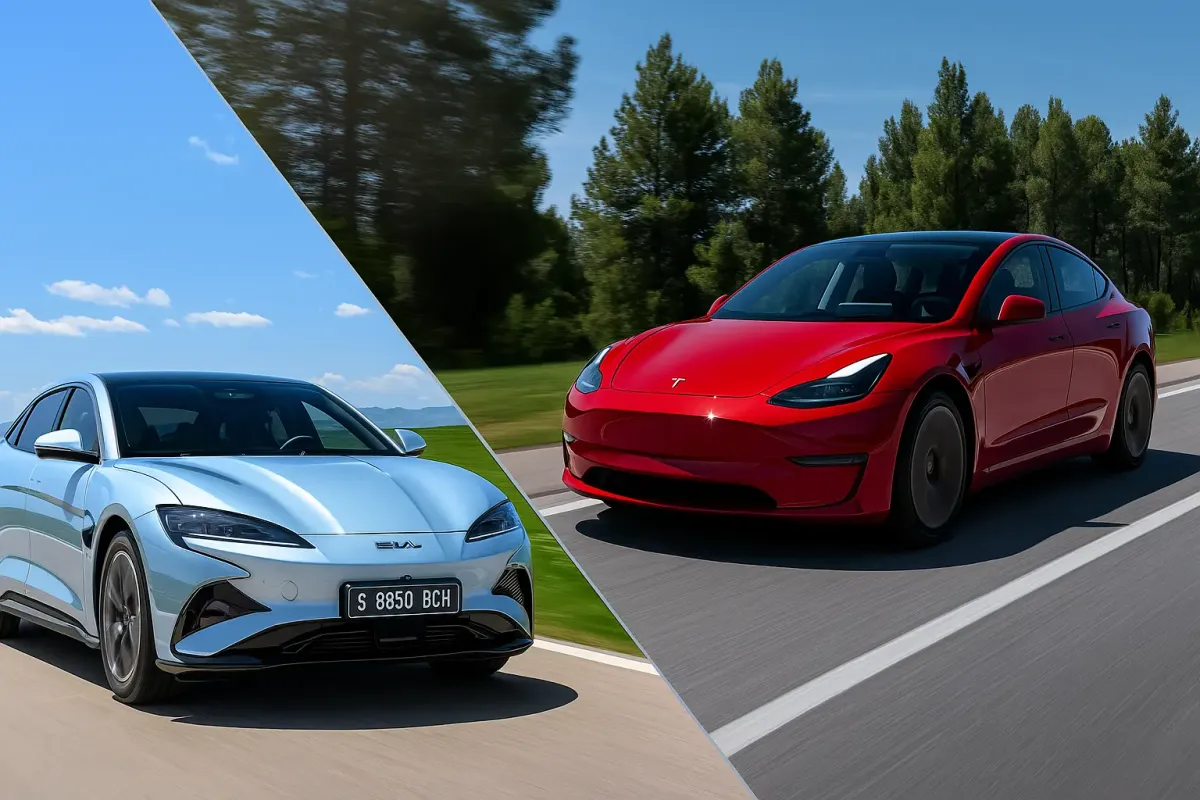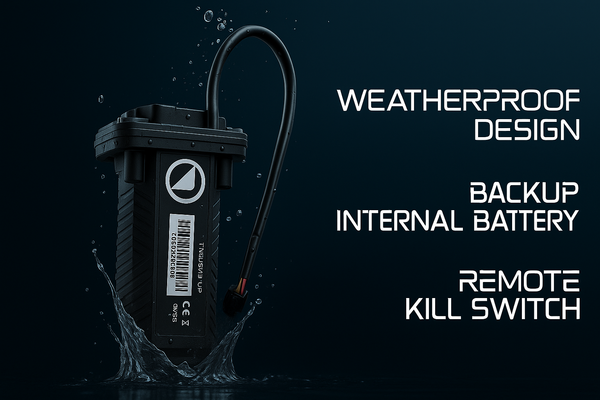2025 Tesla Model 3 vs 2025 BYD Seal:
Discover the key differences between the Tesla Model 3 and the BYD Seal, two electric sedans competing for family friendly driving, modern tech, and strong performance.

Introduction
As electric vehicles (EVs) continue their steady rise in popularity, many families are looking for a car that combines everyday practicality, cutting edge technology, and easy to manage charging solutions. Two models have quickly gained attention among potential EV owners: the Tesla Model 3 and the BYD Seal. Both are stylish, relatively spacious, and designed with modern families in mind.
While Tesla is widely recognized for its pioneering EV technology, BYD holds a significant share of the global market and is gaining a strong foothold internationally. The Model 3 has seen multiple refinements since its original debut, maintaining its reputation for exceptional software, powerful electric drivetrains, and a robust charging network. Meanwhile, the BYD Seal positions itself as a credible alternative with a spacious cabin, unique design, and an interior well suited for comfort.
In this blog, we will compare these two sedans in detail, looking at range, charging efficiency, real world performance, interior layout, tech features, safety equipment, and ownership costs. By the end, you should have a solid grasp of which EV might be the better fit for your family and lifestyle.
(References: Tesla Official Site: https://www.tesla.com/; BYD Global Site: https://www.byd.com/en/; International Energy Agency: https://www.iea.org/)
1. The Rise of Family Friendly Electric Cars
Before diving into the specifics, it helps to understand why family oriented EVs like the Tesla Model 3 and BYD Seal are growing in popularity. Early electric vehicles often struggled with limited range and high costs, making them less practical for day to day family use. However, advances in battery technology, improvements in charging infrastructure, and the production of more aerodynamic, comfortable models have transformed EVs into genuinely viable family cars.
- Lower Running Costs: EVs typically require less frequent maintenance and benefit from cheaper electricity prices compared to gasoline or diesel. Families can save significantly over the lifespan of the vehicle.
- Environmental Benefits: By driving electric, families can reduce their carbon footprint, a factor that resonates with parents who want to set an example for younger generations.
- Practical Features: Modern EVs are designed with everyday needs in mind—think roomy cabins, large infotainment displays, and robust safety features.
Both Tesla and BYD have invested heavily in developing vehicles that meet and even exceed these expectations, culminating in models like the Model 3 and the Seal.
2. Exterior Design and Styling
2.1 Tesla Model 3
The Tesla Model 3’s design language is defined by sleekness and minimalism. The absence of a traditional front grille, smooth body lines, and the near seamless integration of lighting elements emphasize aerodynamic efficiency. One of the vehicle’s defining features is its large glass roof, creating an airy interior ambiance even before stepping inside.
- Aero Optimized Rims: The Model 3 offers wheel choices aimed at reducing aerodynamic drag.
- Flush Door Handles: Their streamlined design helps decrease air resistance.
- Subtle Updates Over Time: Since 2017, Tesla has introduced minor exterior tweaks—new headlights, different wheel trims, and refined bumpers—to keep the Model 3 looking fresh.
Although some might find the styling subdued compared to more aggressively shaped EVs, the Model 3’s understated design appeals to those who prefer a modern yet restrained aesthetic.
2.2 BYD Seal
BYD’s Seal sedan incorporates a more traditional sedan silhouette, yet it layers that shape with striking contours, pronounced character lines, and an upmarket presence. Despite being slightly longer than the Model 3, it carries its dimensions well and looks both sporty and family friendly.
- Prominent Front Fascia: The Seal features a sleek lighting setup and a gently sloped hood that meets the windshield with minimal disruption.
- Sculpted Side Panels: In addition to improving aerodynamics, the etched lines along the sides give the car a sense of motion, even at a standstill.
- Distinct Taillight Bar: BYD’s cohesive rear lighting design is both modern and stylish.
Overall, the Seal’s design aims to merge functionality with a dynamic look, ensuring it can turn heads without alienating drivers who appreciate more understated looks.
3. Powertrain Options and Performance
3.1 Tesla Model 3 Variants
Tesla categorizes the Model 3 into different trims based on battery size, motor configuration, and performance:
- Rear Wheel Drive (RWD): The entry level choice with a single motor. It provides a balanced blend of efficiency and performance at a competitive price point.
- Long Range RWD: Similar single motor setup but equipped with a bigger battery pack. This variant is rated for the longest range among the Model 3 lineup, offering roughly 436 miles on a full charge (under optimal conditions).
- Long Range All Wheel Drive (AWD): Two motors—one for each axle—delivering quicker acceleration and improved grip. Range dips slightly compared to the RWD Long Range.
- Performance AWD: Dual motors set up for maximum acceleration, with 0 60 mph in as little as 2.9 seconds. Range is lower than the Long Range models, but this is the top pick for drivers who crave speed.
These options help Tesla cater to a wide range of preferences, whether someone wants maximum efficiency or thrilling performance. According to the manufacturer (https://www.tesla.com/), each variant benefits from Tesla’s signature instant torque, making for rapid, smooth acceleration in urban and highway settings.
3.2 BYD Seal Variants
BYD has a simpler approach, typically offering two main Seal trims:
- Design (RWD): A single motor combined with an 82.5 kWh battery pack. BYD claims a maximum range of about 354 miles, making it a solid choice for daily commutes and mid range road trips. Acceleration is decent, with a 0 62 mph time of around 5.9 seconds.
- Excellent AWD: Adds a second motor for the front wheels, dropping 0 62 mph to about 3.8 seconds. While extra power is welcome, it slightly reduces the car’s total range. BYD also adds some equipment upgrades here, giving it a more premium feel.
The Seal’s two trim structure is intended to simplify the decision making process. Potential buyers merely decide between better range and affordability (Design trim) or enhanced acceleration with a marginal range decrease (Excellent AWD).
4. Battery Range and Charging
4.1 Real World Range
Manufacturers often list “official” or “claimed” range figures that are achievable under strict testing conditions. In real world settings, range can differ based on driving style, weather, altitude, and the use of climate control systems.
- Tesla Model 3 (Long Range RWD): This version claims up to around 436 miles, but typical highway driving at higher speeds could bring that closer to 350 380 miles in normal conditions.
- BYD Seal (Design RWD): Around 354 miles in official tests, though everyday driving might net somewhere between 300 and 330 miles.
In typical suburban or city driving, both cars often surpass their highway range estimates due to efficient regenerative braking and lower speeds.
4.2 Charging Networks and Speeds
- Tesla Supercharger Network: One of Tesla’s standout advantages. Owners typically enjoy a vast network of high speed chargers, providing quick top offs. The Model 3 can charge at up to about 170 kW. Tesla cites the ability to add up to 172 miles in 15 minutes under ideal conditions.
- BYD Charging: The Seal can handle up to about 150 kW of DC fast charging. BYD states the Seal can go from 10% to 80% in roughly 37 minutes on a compatible fast charger (https://www.byd.com/en/). However, you will rely on third party networks, which can be slightly more fragmented.
It’s worth noting that charging infrastructure continues to expand globally. Depending on where you live, the difference between Tesla’s chargers and those from third party providers might not be as large as it once was.
5. Interior and Technology
5.1 Tesla Model 3: Less Is More
Tesla’s interior philosophy emphasizes minimalism to a degree rarely seen in modern cars. The Model 3 offers:
- Single Center Screen: A 15 inch touchscreen handles nearly all vehicle functions, from adjusting the climate controls to opening the glove box. Drivers initially need an adjustment period, but many come to appreciate the simple layout.
- No Driver Instrument Cluster: Traditional dials or dedicated screens behind the steering wheel have been removed. Instead, speed and other crucial info appear in the top left corner of the center display.
- Clean, Spacious Feel: Without many physical buttons, the dash remains clutter free. The panoramic glass roof also creates an airy ambiance.
Despite the lack of Apple CarPlay or Android Auto, Tesla’s native operating system is known for snappy performance, frequent software updates, and an integrated navigation system that plans trips around available charging points. Over the air (OTA) updates often add new features or improve existing ones.
5.2 BYD Seal: Tech Meets Familiarity
BYD employs a more conventional cabin style while still offering modern features:
- Rotating 15.6 inch Display: The centerpiece of the Seal’s interior can switch between horizontal and vertical orientations. Although not strictly necessary, it can be fun to see maps in portrait mode or watch videos in landscape.
- Driver’s Digital Cluster: A small display sits behind the steering wheel, showing key information like speed, battery level, and navigation prompts.
- Physical Controls and Buttons: While the Seal uses a touchscreen for most infotainment tasks, it retains a few more tactile controls than Tesla, making it more familiar for many drivers.
- Smartphone Integration: The Seal supports wired Apple CarPlay and Android Auto. This allows drivers to integrate their phones’ apps for music, navigation, and messaging, which can be preferable to BYD’s in house software.
The Seal is designed to be user friendly for those who prefer having a bit more physical control without losing that contemporary EV vibe.
6. Cabin Comfort and Practicality
6.1 Space and Seating
- Tesla Model 3: Seats up to five, though taller folks might find rear headroom a bit constrained. The low floor design typical of EVs creates a fairly open feeling, helped by that large glass roof.
- BYD Seal: With slightly larger exterior dimensions, the Seal can feel roomier in the back seat, especially for legroom. The seats come standard with adjustable lumbar support in many markets, which can be a boon for longer journeys.
6.2 Cargo Capacity
- Model 3: Combines the front trunk (often called a “frunk”) with a conventional trunk in the rear. Total cargo space is around 425 liters. The rear trunk opening is somewhat narrow, requiring careful placement of bulky items.
- Seal: Offers a rear trunk and a modest front cargo area, totaling about 453 liters. This extra space can be beneficial when packing for road trips or shopping excursions.
6.3 Noise and Ride Quality
- Tesla Model 3: Early iterations of the Model 3 faced some noise insulation criticisms, but newer revisions show better cabin quietness. The suspension strikes a balance between a sporty and comfortable feel.
- BYD Seal: Slightly softer damping helps absorb city bumps, though it remains composed at highway speeds. Engineered for comfort, the Seal doesn’t pretend to be an outright sports sedan, making it a solid choice for regular family driving.
7. Safety and Driver Assistance Systems
7.1 Tesla’s Approach
Tesla’s commitment to safety is reflected in strong crash test performances and advanced driver assistance features:
- Automatic Emergency Braking: Detects potential front end collisions, applying brakes if the driver fails to do so.
- Lane Departure Warning and Lane Keeping Assist: Helps keep the car centered, providing gentle steering inputs when drifting occurs.
- Adaptive Cruise Control (Traffic Aware): Maintains a set distance from the vehicle ahead, adjusting speed in stop and go traffic.
- Advanced Options: Tesla also offers more advanced driver assistance capabilities, purchasable separately via software updates.
7.2 BYD’s Features
BYD integrates various standard safety technologies in the Seal:
- Multiple Airbags: Front, side, and curtain airbags designed for comprehensive protection.
- Forward Collision Warning: Alerts the driver of obstacles ahead to reduce the likelihood of accidents.
- Lane Departure Warning and Lane Keeping: Similar to Tesla, it helps maintain lane position.
- High Strength Body Structure: By using strong materials around critical areas, BYD aims to protect occupants in various collision scenarios.
Although Tesla’s system might appear more software centric with continuous updates, BYD’s hardware based safety approach provides peace of mind without requiring extra software packages.
8. Ownership Costs and Maintenance
8.1 Initial Purchase Price
- Tesla Model 3: Starts at around £39,990 for the RWD model. As you climb to Long Range AWD or Performance trims, the price approaches or exceeds £50,000.
- BYD Seal: Generally begins at about £45,695 for the Design variant, and £48,695 for the Excellent AWD.
Local incentives, tax credits, or rebates could reduce these out of pocket expenses, so it’s wise to check governmental programs that encourage EV adoption in your area.
8.2 Routine Maintenance
EVs do not require oil changes, and many wear and tear issues common in internal combustion engines simply don’t exist here. However, both Tesla and BYD recommend:
- Periodic Brake Checks: The regenerative braking system reduces typical brake pad wear, but periodic inspections ensure safety.
- Coolant Check (for the battery system): EV batteries need thermal management, usually handled by coolant systems that should be checked at recommended intervals.
- Tire Rotation: Since EVs can be heavier than equivalent gasoline cars, even tire wear is crucial.
8.3 Battery Longevity
Most electric vehicles, including Tesla and BYD models, come with an eight year battery warranty (or a specified mileage limit, often around 100,000 to 120,000 miles). Real world data for Tesla’s older Model S and Model 3 suggests excellent battery durability, commonly retaining over 80% of capacity past 200,000 miles (https://www.consumerreports.org/). BYD’s in house blade battery technology is also lauded for durability and safety, though extensive long term data outside of China is still being collected.
8.4 Depreciation and Resale
Tesla’s strong brand recognition can lead to higher resale values, but BYD has been gaining momentum globally. As more consumers become familiar with BYD’s technology, the Seal’s resale value may see a positive trend. If you plan on driving your EV for many years, the difference might not be substantial, but for short term owners, Tesla’s established market presence often translates to smoother resale opportunities.
9. On Road Experiences
9.1 Handling and Dynamics
- Model 3: Known for its agile, responsive steering. The lower center of gravity (due to the battery placement) makes it fun to drive on twisty roads. Suspension is taut enough to prevent body roll but comfortable for daily commutes.
- Seal: Also benefits from a low center of gravity. It feels stable at highway speeds and comfortable in urban environments. The AWD variant’s extra power and traction help with acceleration, but the Seal’s default tuning leans toward a cushier ride.
9.2 User Feedback
Drivers often praise the Model 3 for its excellent blend of performance and efficiency. Tesla’s ecosystem of software updates and the dedicated Supercharger network bolster an already solid vehicle. Meanwhile, early adopters of the BYD Seal commend its quieter cabin, comfortable seats, and more conventional controls. While it may not have the same “tech forward” reputation Tesla enjoys, many find the Seal’s simpler interface a plus.
9.3 Infotainment Comparisons
- Tesla’s Infotainment: In house system with over the air improvements, streaming services, gaming, and even “Easter egg” features. The catch? No Apple CarPlay or Android Auto, which some might miss.
- BYD’s Infotainment: Less refined user interface in some markets, but the rotating screen is unique. Wired Apple CarPlay and Android Auto integration can trump Tesla’s approach for those who depend heavily on smartphone apps.
10. Pros and Cons Overview
| Category | Tesla Model 3 | BYD Seal |
|---|---|---|
| Price | Lower starting price, though Performance is expensive | Slightly higher entry price for RWD model |
| Range | Up to ~436 miles (Long Range RWD) | Up to ~354 miles (Design RWD) |
| Charging Speed | ~170 kW max; Tesla’s Supercharger network is a big advantage | ~150 kW max; relies on third-party networks for fast charging |
| Performance | Swift acceleration (2.9 sec in Performance trim) | AWD variant at ~3.8 sec to 62 mph |
| Infotainment | Minimalist, fast software, no CarPlay/Android Auto | Rotating screen, includes CarPlay/Android Auto (wired) |
| Interior Comfort | Sleek design, can be firm but improved over older versions | Slightly softer ride, good space, simpler physical controls |
| Safety Tech | Comprehensive driver aids, over-the-air updates | Solid suite of standard safety features, though fewer frequent software updates |
| Overall Practicality | Good for families, solid reliability, large network of service centers | Roomy interior, comfortable for everyday driving, brand expanding globally |
Conclusion
Selecting between the Tesla Model 3 and the BYD Seal depends largely on what you value most in an electric family car. If you prioritize an extensive fast charging network, agile performance, and software driven innovation, the Model 3 is undoubtedly compelling. Its ability to receive over the air updates, combined with Tesla’s strong brand presence, ensures it stays fresh and relevant for years.
On the other hand, the BYD Seal provides a comfortable cabin, a less radical design, and straightforward integration with Apple CarPlay or Android Auto. For drivers who prefer a more traditional interior with select physical buttons and a strong emphasis on comfort, the Seal can be an excellent choice. The brand’s growing presence in various markets suggests that future support and expansions in charging infrastructure could become more robust over time.
Ultimately, both sedans underline the rapid evolution of electric mobility. Families looking for a well rounded EV will likely find that either the Model 3 or the Seal satisfies the key requirements of range, charging convenience, reliability, and a tech forward cabin. Taking a test drive in both and evaluating factors like local charging availability, service center options, and financial incentives can help you land on the perfect match for your needs.
FAQ
1. Which model offers a longer driving range?
The Tesla Model 3 Long Range RWD can reach up to about 436 miles on a full charge, whereas the BYD Seal RWD typically offers around 354 miles.
2. How does charging compare between these two cars?
Tesla’s Model 3 can charge at up to 170 kW via the robust Supercharger network. The BYD Seal charges at around 150 kW, relying on third party fast charging providers, often taking around 37 minutes from 10% to 80%.
3. Are both vehicles suitable for family use?
Yes. Both offer comfortable seating for five, decent cargo space, and features like automatic emergency braking and lane keeping assistance. The Model 3 is known for a minimalist interior, while the Seal provides a more conventional layout.
4. Do they integrate well with smartphones?
Tesla uses its own infotainment system and does not include Apple CarPlay or Android Auto. The BYD Seal includes wired support for CarPlay and Android Auto, which many drivers find more familiar.
5. Which one accelerates faster?
The Tesla Model 3 Performance goes 0 60 mph in about 2.9 seconds. The BYD Seal AWD hits 62 mph in around 3.8 seconds, which is still very quick for an everyday family sedan.
6. How about interior noise and refinement?
Newer Model 3 versions have improved insulation, offering a quieter cabin than older Teslas. The BYD Seal also emphasizes comfort, using slightly softer suspension to maintain a composed ride.
7. Is maintenance cost significantly different between them?
Both are electric vehicles and share similar low maintenance profiles (no oil changes, fewer moving parts). The main differences lie in service network availability: Tesla’s established centers vs. BYD’s growing presence in global markets.
8. Do they both offer over the air software updates?
Tesla is renowned for OTA updates that can add new features or improve efficiency. BYD may offer some updates, but it does not currently match Tesla’s frequency or breadth of software changes.
9. Which one is more budget friendly?
The base Tesla Model 3 is generally cheaper than the entry level BYD Seal, though final costs depend on local EV incentives, taxes, and trim choices.
10. Are these cars recommended for road trips?
Yes. Both can handle road trips well. Tesla’s Supercharger network often makes longer journeys easier, though BYD Seal drivers can plan routes with third party charging stations. The comfort factor in both cars is suitable for extended periods on the road.
(References: Tesla Official Site: https://www.tesla.com/; BYD Global Site: https://www.byd.com/en/; International Energy Agency: https://www.iea.org/)





